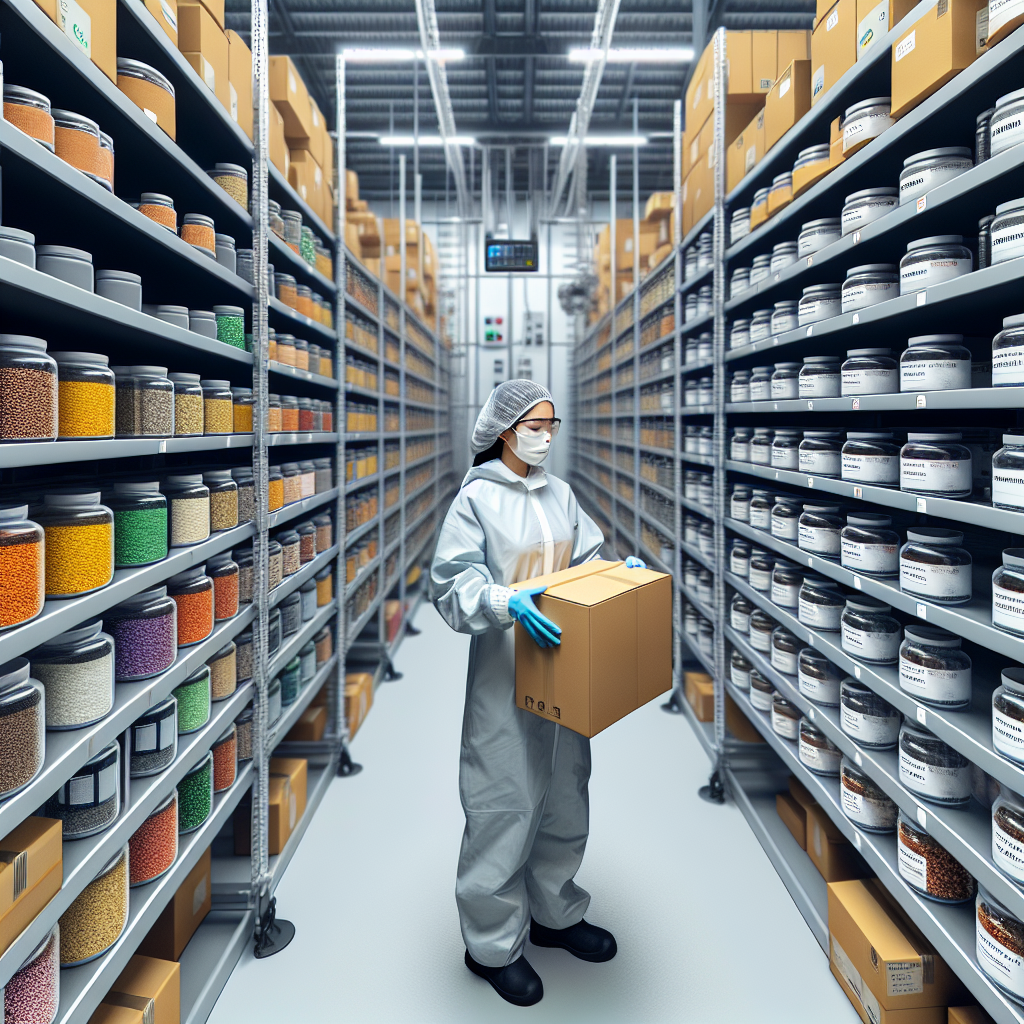Key Takeaway: Proper raw material storage is the foundation of quality supplement manufacturing. This comprehensive guide outlines the seven essential steps every manufacturer must follow to maintain ingredient integrity and avoid costly quality issues.
In the competitive world of supplement manufacturing, the difference between exceptional and mediocre products often lies in the details that consumers never see. Behind every high-quality nutritional supplement is a meticulously managed raw material storage procedure that preserves ingredient integrity from arrival to production. At NutraAeon, we’ve witnessed how proper storage protocols can significantly impact final product quality, consumer satisfaction, and ultimately, a manufacturer’s reputation in the marketplace.
Improper storage of raw materials can trigger a cascade of costly consequences: diminished potency, contamination, regulatory non-compliance, and even product recalls. For forward-thinking supplement manufacturers, implementing robust raw material storage procedures isn’t just about following rules—it’s about establishing a foundation for product excellence that aligns with evolving consumer expectations for transparency and quality.
Let’s explore the seven critical steps in raw material storage procedure that every manufacturer must implement to avoid quality issues and elevate their products in today’s demanding market.
1. Receiving Raw Materials: The Critical First Line of Defense
The journey of quality begins the moment raw materials arrive at your facility. A comprehensive raw material verification procedure serves as your first opportunity to prevent quality issues before they enter your supply chain.
Upon delivery, all incoming materials should undergo immediate inspection against purchase orders, checking for:
- Correct material identity and specifications
- Matching quantities
- Intact packaging with no signs of damage
- Proper documentation, including certificates of analysis
- Batch numbers and expiration dates
“The most common quality issues we see stem from inadequate receiving protocols,” explains a quality assurance expert. “Manufacturers who rush through this process often pay tenfold in quality problems downstream.”
After initial inspection, all materials should enter a designated quarantine area—physically separated from approved inventory—until quality testing confirms they meet specifications. This quarantine system embodies NutraAeon’s commitment to transparency and quality, ensuring that only verified materials move forward in the production process.
Implementing a clear sampling protocol during receiving is equally important. For example, amino acid ingredients like L-Theanine or L-Tryptophan require verification of purity levels before release from quarantine, while vitamin compounds may need potency confirmation. These testing protocols should align with both regulatory requirements and your internal quality standards.
2. Storage Requirements: Protecting Material Integrity
Once materials pass initial inspection, proper storage becomes paramount. Different raw materials have specific storage requirements based on their physical and chemical properties.
Key storage considerations include:
- Designated storage areas for different material categories
- Clear separation of similar-looking materials to prevent mix-ups
- Protection from environmental factors like heat, light, and moisture
- Proper container selection based on material properties
- Storage away from walls and off floors to prevent moisture damage and facilitate cleaning
For nutritional ingredient manufacturers, implementing a First-In-First-Out (FIFO) or First-Expired-First-Out (FEFO) inventory management system is essential. These systems ensure that older materials are used before newer ones, minimizing the risk of ingredient expiration and associated financial losses.
Many quality-focused manufacturers like those partnering with NutraAeon are now implementing specialized storage solutions for different ingredient categories. For example, amino acids often require different storage conditions than vitamin compounds or mineral ingredients. Creating dedicated storage areas for each category dramatically reduces cross-contamination risks and improves traceability.
3. Organization and Labeling: The Foundation of Traceability
Perhaps no aspect of raw material storage procedure contributes more to error prevention than proper organization and labeling. A well-organized storage system with clear, consistent labeling protocols supports both quality control and operational efficiency.
Effective labeling systems should include:
- Material name and unique identifier code
- Supplier information
- Batch or lot number
- Date received and expiration date
- Storage requirements
- Status indicators (quarantined, approved, rejected)
- Hazard information when applicable
Color-coding systems can further enhance organizational clarity. For instance, using different colored labels for amino acids versus vitamin ingredients helps prevent mix-ups during picking processes. Similarly, distinct visual indicators for quarantined versus approved materials reduce the risk of using untested ingredients.
Barcode or QR code systems linked to inventory management software take organization to the next level, enabling real-time tracking and automated documentation—a perfect reflection of NutraAeon’s commitment to supply chain visibility and transparency. These systems allow manufacturers to instantly access a material’s complete history, from receipt through quality testing to final usage.
“When we implemented barcode scanning for all raw materials, our picking errors dropped by 98%,” reports one supplement manufacturer. “The investment paid for itself within three months through prevented quality issues alone.”
4. Environmental Controls: Preserving Potency and Purity
Nutritional ingredients are often sensitive to environmental conditions. Controlling temperature, humidity, light exposure, and air quality is essential for maintaining material integrity throughout storage.
Critical environmental factors to monitor include:
Temperature control: Many supplement ingredients degrade rapidly at high temperatures or freeze at low temperatures. Dedicated climate control systems with continuous monitoring and alarm capabilities are essential investments for quality-focused manufacturers.
Humidity management: Excessive moisture can trigger chemical degradation, promote microbial growth, and cause clumping of powdered ingredients. Dehumidification systems are particularly important for hygroscopic materials like many vitamin compounds.
Light protection: UV and visible light exposure can degrade light-sensitive ingredients, particularly certain vitamins and natural compounds. Opaque containers and controlled lighting in storage areas help preserve potency.
Air quality: Filtration systems that remove particulates and contaminants protect raw materials from airborne contamination during storage.
For supplement manufacturers handling premium ingredients like those supplied by NutraAeon, environmental monitoring systems should provide continuous data logging with alert capabilities. These systems align with our philosophy of quality and transparency by creating documented evidence of proper storage conditions throughout an ingredient’s lifecycle.
A temperature excursion of just a few hours can permanently damage certain vitamin ingredients, while excessive humidity can compromise the integrity of mineral compounds. Implementing 24/7 environmental monitoring with automated alerts ensures rapid response to any deviations before they impact material quality.
5. Access Control and Training: Human Factors in Quality Preservation
Even the most sophisticated storage systems depend on proper human interaction. Restricting storage area access to trained personnel and implementing comprehensive training programs significantly reduces error risk.
Effective access control measures include:
- Secure, limited-access storage areas
- Electronic key cards or biometric access systems
- Logged entry and exit records
- Supervision requirements for trainees
- Clearly defined handling procedures
Training programs should cover not just basic procedures but also the scientific rationale behind storage requirements. When staff understand why certain materials require specific handling, compliance improves dramatically. This approach aligns with NutraAeon’s emphasis on empowerment through knowledge.
Training should be ongoing, with regular refreshers and updates as procedures evolve. Documentation of training completion creates accountability and supports regulatory compliance. Additionally, cross-training multiple staff members ensures continuity during absences or staff changes.
“Our most significant quality improvements came not from new equipment but from better staff training,” notes a quality director at a leading supplement manufacturer. “When people understand the ‘why’ behind procedures, they make better decisions in unpredicted situations.”
6. Cleaning, Maintenance, Documentation and Record-Keeping
The integrity of a raw material storage procedure depends on rigorous cleaning, preventive maintenance, and meticulous documentation. These elements create the accountability and traceability that regulators demand and consumers increasingly expect.
Cleaning and maintenance best practices include:
- Scheduled cleaning protocols for all storage areas
- Documented cleaning procedures and logs
- Pest management programs
- Regular equipment calibration and maintenance
- Preventive maintenance schedules for environmental control systems
Documentation requirements typically encompass:
- Material receiving records
- Quarantine and release documentation
- Environmental monitoring logs
- Inventory movement records
- Staff training records
- Cleaning and maintenance logs
- Internal audit results
Modern supplement manufacturers are increasingly leveraging digital systems for documentation management. Cloud-based platforms enable real-time data entry, automated reporting, and secure record storage. These technologies align perfectly with NutraAeon’s modern approach to supply chain visibility, creating seamless documentation trails from receipt to production.
“Paper-based systems simply can’t provide the reliability and accessibility needed in today’s regulatory environment,” explains a compliance expert. “Digital documentation systems reduce human error and create instant traceability during audits or investigations.”
7. Continual Review and Audits: Evolution for Excellence
The final critical component of an effective raw material storage procedure is the commitment to continual improvement through regular reviews and audits. In the rapidly evolving supplement industry, storage protocols must adapt to new ingredients, changing regulations, and advancing technologies.
An effective review and audit program includes:
- Scheduled internal audits of storage areas and procedures
- Gap analyses against current regulatory requirements
- Review of any deviations, incidents, or near-misses
- Assessment of new technologies and best practices
- Feedback mechanisms for staff suggestions
- Documentation of improvement actions
Leading manufacturers conduct comprehensive storage procedure reviews at least annually, with more frequent targeted audits of specific areas. These reviews often identify opportunities for efficiency improvements alongside quality enhancements.
This commitment to continual improvement mirrors NutraAeon’s vision of helping clients stand out in a competitive landscape. By regularly refining raw material storage procedures, manufacturers can ensure they’re not just meeting current standards but exceeding them—positioning their products as industry leaders.
Conclusion: From Procedure to Competitive Advantage
While raw material storage procedure may seem like a behind-the-scenes operational detail, its impact extends throughout a supplement manufacturer’s business. Properly stored ingredients maintain their potency, interact as expected during production, and deliver the results consumers expect in the final product.
The seven critical steps outlined above—receiving protocols, storage requirements, organization and labeling, environmental controls, access controls and training, documentation, and continual improvement—form the foundation of a robust storage system that prevents costly quality issues before they occur.
For manufacturers partnering with premium ingredient suppliers like NutraAeon, implementing these practices creates a seamless quality chain from sourcing through production. When exceptional ingredients are maintained under optimal conditions, the resulting products truly stand out in today’s competitive marketplace.
The investment in proper raw material storage procedure isn’t just about regulatory compliance—it’s about creating a foundation for product excellence that builds consumer trust, enhances brand reputation, and ultimately drives business success through superior quality.
Ready to elevate your raw material management? Implementing these seven critical steps will not only safeguard your product quality but also establish your manufacturing operation as an industry leader. Contact NutraAeon today to learn how our premium ingredients and quality-focused approach can help you create exceptional nutritional supplements.


